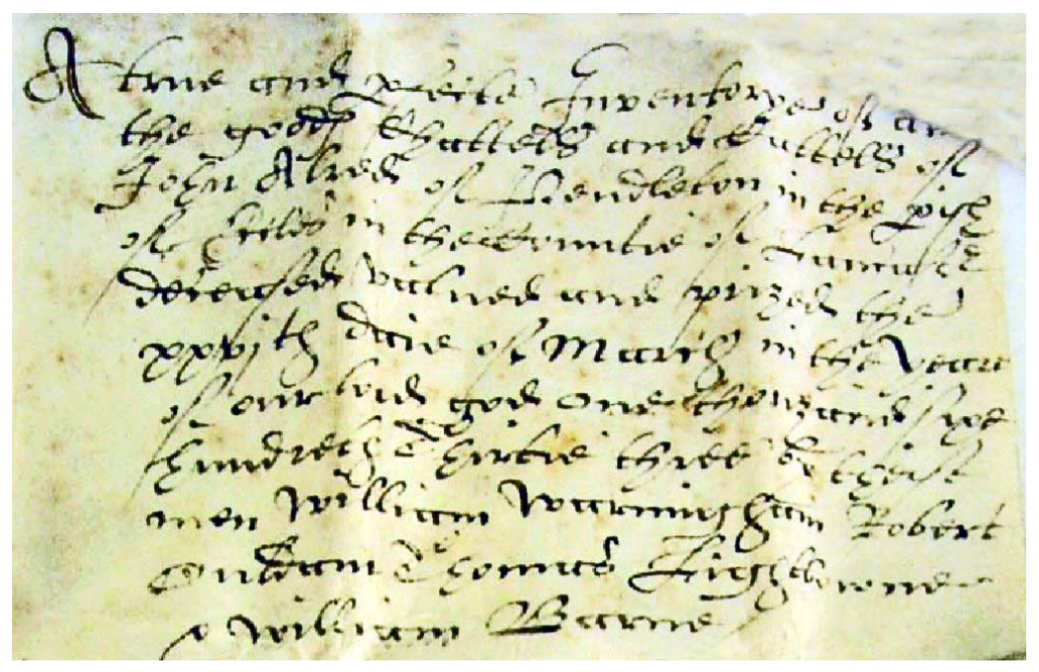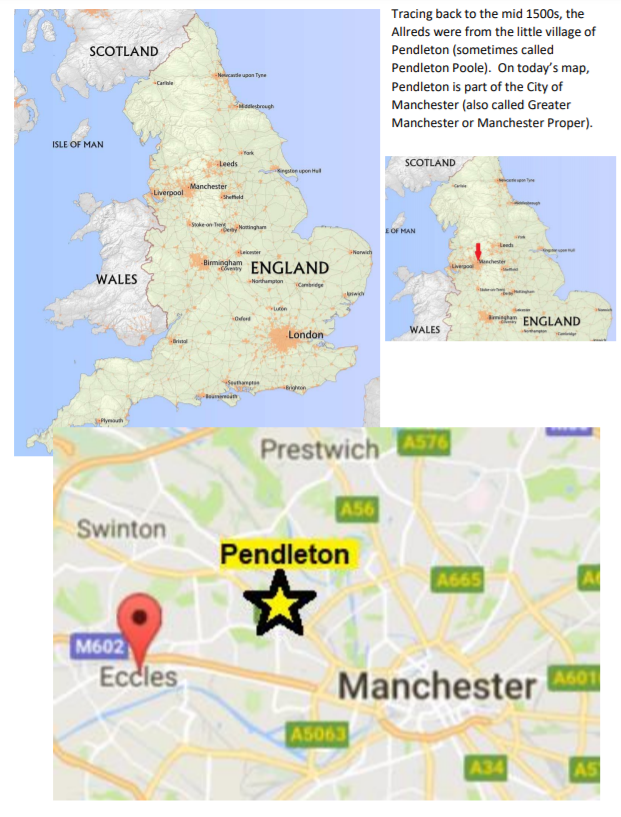
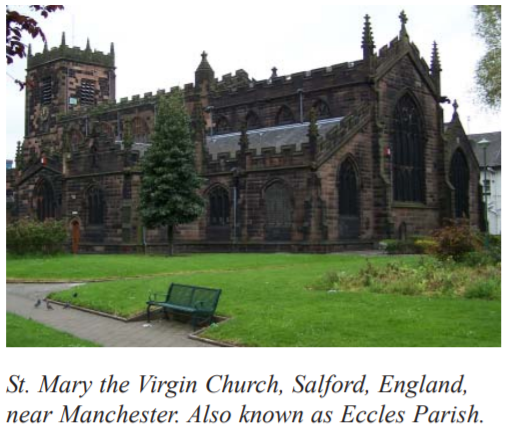
Pendleton, Lancashire, England – The Allred Ancestral Home
by John Allred, Dublin, Ohio
Originally published in AFO Newsletter # 97, Winter 2013
Numbers surrounded by () refer to footnotes you will find at the end of this report
If you have a paper trail and/or DNA evidence showing you are related to the Allreds who settled in North Carolina in the mid-1700s, then you have a pretty solid connection to John Allred of Lancashire, England, who lived from about 1571 to 1632. That connection has been built by several people over a long period of time, as chronicled by the MyAllredFamily.com web site administered by Linda Allred Cooper. In a herculean effort, Linda has created an Allred Time Line on the AFO Website that connects the dots over the four centuries of Allred family history. (This Time Line will be updated and published on the website at a future date - as time allows.)
The purpose of this article is to highlight the importance of the little English village of Pendleton in the identification of our early ancestors. Throughout the 17th century, Allreds and other people in their lives were listed in church records and other documents as being from this particular village. In the 1600s, Pendleton was a tiny, agricultural village located in Lancaster County (or as the English say, “Lancashire”) England. While this small village had little import in the world, it is of major importance to us. It was the home of a branch, in fact our branch of the Allred family. The documents reviewed here confirm this historical connection previously established.

William Penn wrote a letter on January 16, 1686, connecting the village of Pendleton to John Allred - our John Allred, Solomon’s father. The letter was written from Manchester, England, to William Penn’s Quaker Friend and estate manager, James Harrison, in Bucks County, Pennsylvania. The letter stated “I have an eye to the man thou writ about and his family but one John Aldred of
Pendleton related to P. Pemberton yet came to me at Manchester to be helped over on the terms I published for the poor. I may do what I can for him.” The P. Pemberton mentioned in the letter as John Allred’s relative was undoubtedly Phineas Pemberton, the son-in-law of the recipient of the letter, James Harrison. This is significant because Phineas was a cousin to Ellen Pemberton, Solomon’s mother. Thus, William Penn was clearly writing about our John Allred, from Pendleton, father of Solomon and husband of Ellen Pemberton.
The letter from William Penn and the abstract of the Solomon Allred letter were previously discussed by Linda Allred Cooper’s article: “John Allred’s Attempts to Come to America,” Allred Family Newsletter, Issue 91, Summer, 2012. Why would William Penn, son of Admiral Sir William Penn who was a confidant of King Charles II, meet with a lowly, destitute peasant? There were two reasons. First, there was a religious connection. William Penn was a Quaker and was, in fact, a good friend to George Fox, founder of the Quaker faith. Ellen Pemberton Allred and John Allred were early participants in the newly formed Quaker faith and were both arrested because of their attendance at Quaker meetings in 1661. (1)
Second, there was the family connection of John Allred, through his wife Ellen, to the Pemberton family. No doubt, William Penn wanted to help anyone related to the Pembertons because they were an influential (and wealthy) Quaker family. Of course, John Allred of Pendleton was only related to the Pemberton family by marriage – Ellen was the blood relative and she had died earlier on December 21, 1684 – but even relatives by marriage deserved help in the Quaker family.
Long-term researchers of the Allred family know the story of “Ellin” (Ellen) Pemberton. She was born March 25, 1638, in Eccles
(rhymes with “heckles”) parish, Lancashire as the illegitimate daughter of Margery (Margaret) Smith and John Pemberton. Margaret was the daughter of Anne and Thomas Smith - Thomas was the Eccles parish clerk. (2) Margaret’s mother, Anne Smith, was buried on
January 18, 1638, less than a year (3) after Ellen was born, which is perhaps why Ellen was raised by the Pemberton family instead of the Smith family. Although Thomas Smith remarried on June 26, 1639, to Mary Lever. Besides, it must have been embarrassing for Thomas Smith, as a long-term official of the Church, to have an illegitimate granddaughter, especially since it was his duty to record in the Church records the circumstances of her birth. It is not clear when Thomas Smith became the parish clerk but he was listed as such when he witnessed the induction of John Jones as Vicar of Eccles parish on January 18, 1610. He likely held that post until his death on March 3, 1648, ten years after Ellen was born.
John Pemberton, Ellen’s father, was born about 1617 in Lancashire, England. He was thus 21 years old when Ellen was born and Margaret (born February 18, 1620), Ellen’s mother, was about 18. While Ellen supposedly was raised by John’s parents, William and Anne Pemberton, several sources suggest that both William and Anne Pemberton died in 1642 when Ellen was only four years old. If this is true, she may have spent the remainder of her formative years in the home of her uncle, Ralph Pemberton and his wife Margaret, since she seemed to be so close to their family in later years. In any case, it was Ralph’s son Phineas to whom William Penn referred when he identified John Allred of Pemberton as being related to “P. Pemberton.”
Finally, it was Israel Pemberton, living in Philadelphia, to whom Solomon Allred wrote on January 19, 1719, asking for help in obtaining a land grant in Chester County, Pennsylvania. Israel was Ralph Pemberton’s grandson and Phineas Pemberton’s son. Although the letter has not been found, the following abstract was found in the Gilbert Cope collection at the Historical Society of
Pennsylvania:
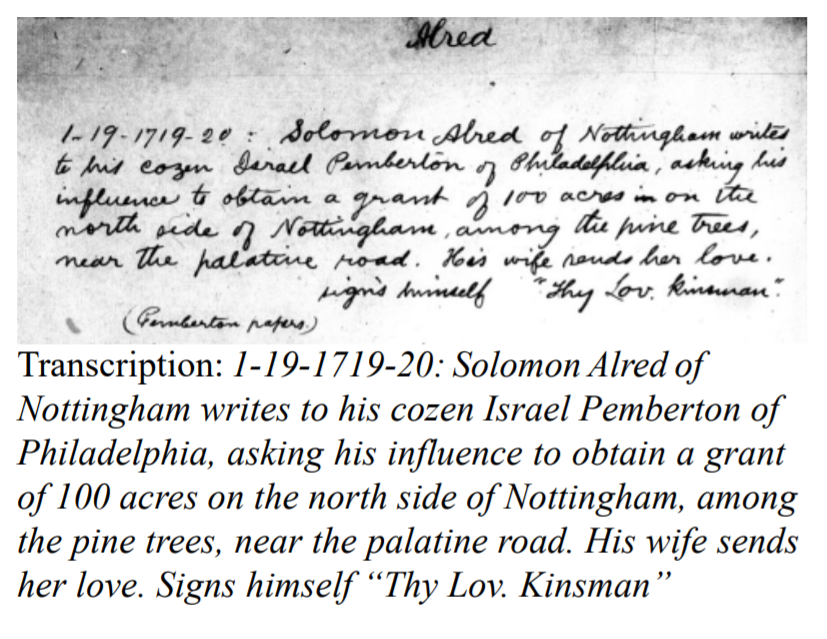
Note, that Solomon calls Israel a cousin (cozen). This letter along with that from William Penn connect the Allred family in America to John and Ellen Pemberton Allred and their son, Solomon, and more importantly to our story, to the little village of Pendleton in
Lancashire, England.
History of the Village of Pendleton
Pendleton existed as a named village for more than 1000 years. It was listed in the “Doomsday Book” as “Peniltune.” The Doomsday Book was a census of people and property ordered by William the Conqueror after he won the Battle of Hastings in 1066 to become King of England. If the village existed in 1066, it must have been there before although documentation in the form of a written record is not available. But in fact, there is evidence (4) of human habitation 7,000 to 10,000 years ago in the form of flint arrow-heads, scrapers and knives. The name of the village changed many times: it was known as Penelton in 1199, Pennelton in 1212, Penilton in
1236, Penhulton in 1331, Penulton in 1356 and, finally Pendleton from about 1600.
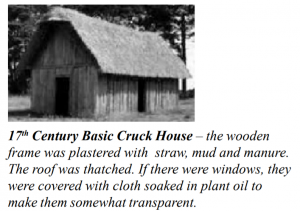 Pendleton was a small part of the ancient Parish of Eccles with Saint Mary the Virgin as the parish Church, established before the 13th-century. To illustrate how small Pendleton was, Eccles parish encompassed an area of about 22,000 acres, with just over 7,500 described as “arable” meaning that it was suitable for farming. (5) But Pendleton had only 12 of those acres that could be cultivated with another 562 acres of grassland. Twelve acres is not much to grow food on but it may have been all that they could handle unless someone had oxen to do the plowing. The more primitive method of land preparation for planting was the “foot plow” that resembled a modern spade. Grass land was used for grazing animals – sheep, goats and cattle. It is possible that land from other villages in the parish was used for food production because in 1666 the tax rolls indicated that there were 138 hearths (fireplaces) but this did not
Pendleton was a small part of the ancient Parish of Eccles with Saint Mary the Virgin as the parish Church, established before the 13th-century. To illustrate how small Pendleton was, Eccles parish encompassed an area of about 22,000 acres, with just over 7,500 described as “arable” meaning that it was suitable for farming. (5) But Pendleton had only 12 of those acres that could be cultivated with another 562 acres of grassland. Twelve acres is not much to grow food on but it may have been all that they could handle unless someone had oxen to do the plowing. The more primitive method of land preparation for planting was the “foot plow” that resembled a modern spade. Grass land was used for grazing animals – sheep, goats and cattle. It is possible that land from other villages in the parish was used for food production because in 1666 the tax rolls indicated that there were 138 hearths (fireplaces) but this did not
mean 138 dwellings. The manor house had nine hearths and several other dwellings had five each. The common villagers lived in a “cruck house” which did have one hearth but no chimney. The hearth, for heat and cooking, was placed in the middle of the room
with a hole above in the roof. There must have been about a hundred of these cruck houses in 1666 based on the number of hearths taxed, which suggests the population may have been a few hundred people. As late as 1780, the village was described as rural with a
group of cottages around a village green with a maypole.
In modern times, there are two areas in Lancashire with the name “Pendleton” which can be confusing. There is a small village named Pendleton, Whaley parish, near Pendle Hill, about 30 miles north of Manchester, apparently founded in the early 1800s. That area was known in earlier times as a wild and dangerous place and was the site of the Pendle Hill witch trials in 1613. But the Pendleton of our ancestors (6) is in Eccles parish and is now a township about two miles northwest of Manchester in the city of Salford. The parish church, Saint Mary the Virgin, attended by our ancestors, is also located in the city of Salford.
People of Pendleton
Pendleton must have been small in the 1600s or it would not have been practical to identify inhabitants with the phrase “of Pendleton.” That is, if there had been two or more Allred families living in Pendleton, the “of Pendleton” phrase would not have
distinguished them. It is likely that even at this early time, the Allred family was relatively large and diverse. Since John was a popular Christian name, it stands to reason that there may have been several John Allreds. But the identifier “of Pendleton” distinguished a particular John Allred. Even so, we know that sometimes there were two John Allreds, likely father and son, living in Pendleton at the same time and they were distinguished by the adjectives “younger” and “elder.” All of this is to say that we are very fortunate in our
search for our ancestors that they lived in such a small village and that they identified with that village. William Penn’s letter, discussed earlier, shows that late in the 1600s, John Allred, father of Solomon, still identified with Pendleton. In this section, the preamble of three probate records is presented, spanning most of the 17th century, all of whom are identified by the phrase “of Pendleton.”
The first of these is the probate record of John Allred (7) “of Pendleton” who was buried March 20, 1632. This is one of the earliest such records available.
Transcription:
A true and perfect Inventory of all the goods, chattel and cattle of John Alred of Pendleton in the (parish) of Eccles in the countie of Lancaster Inventoried, valued and prized on the 26th (xxvi) day of March in the year of our God one thousand six hundred and thirty three by these men William Warmingham Robert Oldham Edmund _____ William ______-.
Note that John Allred’s burial date was March 20, 1632, yet the date of inventory for his probate record was March 26, 1633. The calendar in use at the time had March 25 as the New Year’s Day (see endnote 4) so the probate record was made only 6 days after
John was buried, not a year!
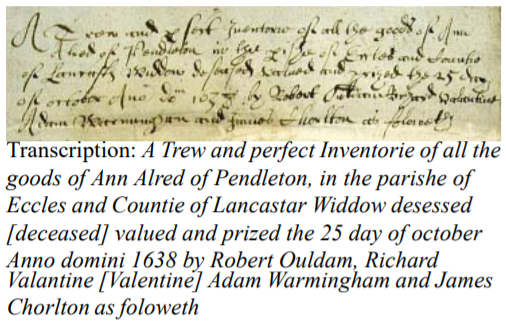 This John Allred and Ann Taylor Allred (8) were married at the parish Church, Eccles, on May 27 1589. Ann Allred “of Pendleton” left a will dated December 13, 1637, in which she named five living children: three girls and two boys. The girls, all married, were Ann Travis (husband John), Elizabeth Bradshaw (Adam), and Katheryn Ouldam (Robert). The boys were William and John, with William being the eldest. Ann was buried on October 23, 1638. The preamble to her probate record, prepared two days after Ann was buried in the Saint Mary the Virgin Church cemetery, is shown here.
This John Allred and Ann Taylor Allred (8) were married at the parish Church, Eccles, on May 27 1589. Ann Allred “of Pendleton” left a will dated December 13, 1637, in which she named five living children: three girls and two boys. The girls, all married, were Ann Travis (husband John), Elizabeth Bradshaw (Adam), and Katheryn Ouldam (Robert). The boys were William and John, with William being the eldest. Ann was buried on October 23, 1638. The preamble to her probate record, prepared two days after Ann was buried in the Saint Mary the Virgin Church cemetery, is shown here.
Finally a probate record (9) was completed on April 2, 1675, for another John Allred “of Pendleton” who must have died a few days earlier but is not listed in the Eccles parish records, most likely because he had left Saint Mary the Virgin Church, along with Vicar Edmund Jones. Both were arrested on October 12, 1673, for attending a Presbyterian meeting. John Allred was identified among those arrested as being from Pendleton. The preamble to his probate record is shown here. 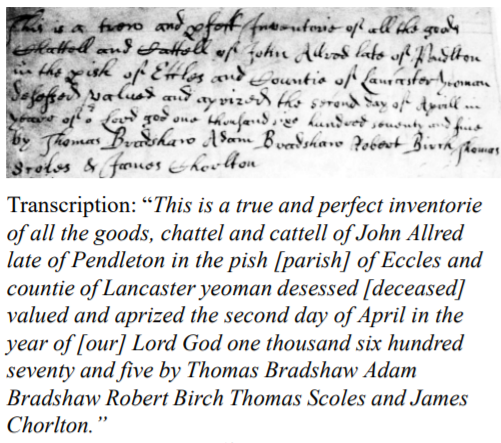
A case has been made (10) that this John Allred was the son of John and Ann Allred whose probate records are shown above. This conclusion is based upon the fact that this inventory record is signed by Adam Bradshaw who was most likely John’s brother-in-law. Elizabeth Allred, daughter of John and Ann Allred, married Adam Bradshaw on March 19, 1632. In addition, James Chorlton, listed on Eccles Church records as being from Pendleton, witnessed Ann Allred’s will and signed her probate record in 1638, as well as signed the probate record of John Allred, written in 1675.
Note that all of the preambles to wills have the same format and much of the wording is identical. There was little change in the form of these documents over more than four decades. Moreover, the people listed
in these documents were neighbors. In addition to James Chorlton mentioned above, others in these documents are listed on church records as being from Pendleton. These include Richard Valentine, who signed Ann Allred’s probate record as well as Richard Birch, Thomas Bradshaw and Adam Bradshaw, all of whom signed the probate record for John in 1675.
Finally, John Travis, who married Ann and John Allred’s oldest daughter Ann in 1621 and Elizabeth Bradshaw, second daughter of Ann and John Allred, were identified in church records with the phrase “of Pendleton.”
Confirmation of the Connected Dots
There has been much evidence collected over a long period of time by dedicated researchers which established that the American Allreds of 18th Century North Carolina descended from the Allreds who lived in Eccles parish, Lancashire, England. The documents
reviewed here seem to confirm that these Allreds had a great, great grandfather named John Allred “of Pendleton” who lived from about 1571 to 1632. While there are still some uncertainties in some details, if you have a documented relationship with the Allreds of North Carolina, then you have a pretty firm connection to 16th Century England and the village of Pendleton.
(Endnotes)
1 Sufferings of Early Quakers by Joseph Besse. Printed and sold by Luke Hinde, London, 1753.
2 Thomas and Anne Smith had another daughter, Margaret’s sister, named Ellin (Ellen) which may have been the namesake of Ellen Pemberton. Church records entry: “Ellin d. of Thomas Smith, pish (parish) clerk 18 Feb 1620.”
3 According to Eccles Church records. At first glance, the date of Ellen’s birth of March 25, 1638 was after her grandmother, Anne Smith’s death - she was buried on January 18, 1638. But by the calendar in use at the time, New Year’s Day was March 25, Ellen’s birthday and therefore the first day of 1638 and January 18, 1638 was eleven months later.
4 http:/en.wikipedia.orgwikiSalford, _Greater_Manchester
5 http://en.wikipedia.org/wikiEccles,_Greater_Manchester
6 http://www.visionofbritain.org.uk/descriptions/965510
7 Listed as John Alred “theldr” (the elder) in Eccles Church records on a CD: English Parish Records, Lancashire. From Ancestry.com.
8 The information on Ann Allred was discussed previously by John Allred, Ann Allred of Pendleton: Her Will (1637) and Her Probate Inventory Record (1638)” Allred Family Newsletter Issue 86, Spring 2011
9 This document was also previously discussed by John Allred, In 1673, John Allred and Edmund Jones Were Arrested for Illegal Worship – Who Were They? Allred Family Newsletter Issue 90, Spring 2012

